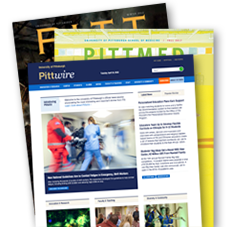Excerpts from Nobel Laureate Paul C. Lauterbur's Address for the University of Pittsburgh's 2004 Commencement at Pitt's Petersen Events Center on Sunday Afternoon, April 25, 2004
PITTSBURGH—University of Pittsburgh Alumnus and Nobel Laureate Paul C. Lauterbur spoke at the 2004 Pitt Commencement this afternoon of his scientific research and his resultant discoveries that led to the development of magnetic resonance imagery and a shared 2003 Nobel Prize in Physiology or Medicine.
"The very early days of this work," Lauterbur said, "actually started, surprisingly, about the time I was in junior high school, where I got interested—and this will be important later—in many different things, one of them the chemistry of silicone, and I did experiments in my home laboratory at that time." He then talked about going to college at "what was then Case Institute of Technology in Cleveland," moving to Pittsburgh to work at the Mellon Institute, which was at the time a unit of the University of Pittsburgh, and earning a doctorate at Pitt. While he was working at the Mellon Institute and working toward his Pitt degree, he studied nuclear magnetic resonance. But "my draft board decided that that was enough. 'You have been deferred for long enough. If we aren't careful, you're going to get out of your military service,' so they drafted me into the Army," where he helped set up a laboratory and worked with "other marginal types, like Harvard Ph.D.s" and "out of it got, eventually, four scientific papers, which is more than you usually get out of service in the Army."
Lauterbur returned to the Mellon Institute and his pursuit of his Pitt Ph.D., which he received in 1962, and spurned advances from industry jobs to undertake a career in academia. As part of his continuing quest to solve the MRI puzzle, Lauterbur recalled that he worked at the end of one academic year for a company in New Kensington, Pa., near Pittsburgh. "I went out to dinner [one] night at a Big Boy restaurant" with a friend from the company ("We were living high off the hog in those days") and they "chatted about what the possibilities might be." In time, he "got to thinking about…using something I'd learned in a graduate course at Pitt" and began asking himself questions like whether one could "ever get a big enough signal from something as large as a human being" and "could anybody build magnets big enough to put people in? This was a very new sort of thing." After doing his own experiments and involving undergraduate students and "much later some graduate students and postdocs" in his research, "eventually, other people around the world,
other universities, and industry began to pick up on the ideas, so gradually the field developed. And it's only because so many people picked up on these things and decided to work with them that I am here today. Because, of course, no one gets such improbable honors just for having an idea—it has to work, it has to have some effects in the world."
He stated that a "take-home" lesson from his life story was that "no matter what happens, your experiences and education and even getting drafted into the Army, can all be of assistance to a developing career, even though you never think so at the time. But if you keep after what you're after and make appropriate choices from time to time, and they turn out to be things that other people will eventually, though not originally, agree to, and if you have a new idea, you do have to live through a period when you are called an idiot by the most qualified people you can imagine, like Nobel laureates…. But you have to persevere. And the take-home lesson, and there always is one for a commencement speech, is do whatever really excites you in your life and do it as best you can, and if you have enough luck, it will work out."
###
4/26/04/tmw
Media Resources
Schools of the Health Sciences Media Relations
For more information about Pitt's schools of dental medicine, health and rehabilitation sciences, medicine, nursing, pharmacy, and public health, click here >
To locate stories from health science schools prior to 2013, visit the UPMC news archives »
Urgent Question?
University of Pittsburgh news reps are available to answer urgent media inquiries. Outside of regular business hours (Mon-Fri, 8:30 a.m.-5 p.m.), please email us at media@pitt.edu.
News reps for University of Pittsburgh Health Sciences schools can be reached outside of regular business hours through the paging operator at 1+412-647-2345.


